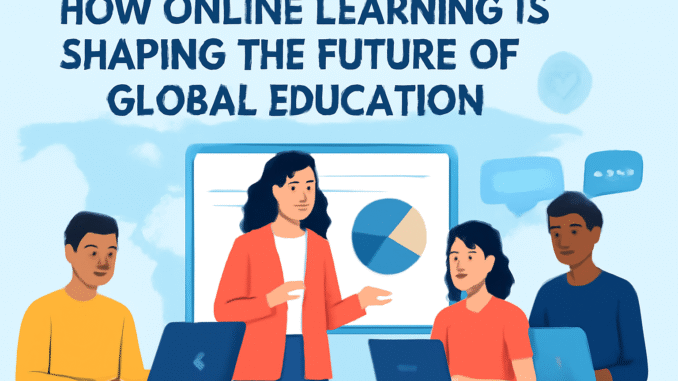
How Online Learning is Shaping the Future of Global Education
In recent years, online learning has evolved from a supplementary educational tool to a fundamental element of global education. The COVID-19 pandemic acted as a catalyst, accelerating the adoption of online education worldwide. What began as a necessity quickly turned into an opportunity to innovate and redefine traditional learning. As we look towards the future of education, online learning continues to break down barriers, offer unprecedented flexibility, and redefine the boundaries of what’s possible in education.
Online learning has become a powerful tool that enhances accessibility, provides tailored learning experiences, and fosters greater collaboration between students, teachers, and institutions. In this article, we will explore how online learning is shaping the future of global education and why it is here to stay.
1. Expanding Access to Education
One of the most significant ways in which online learning is revolutionizing education is by expanding access. For decades, millions of students worldwide were limited by geography, financial constraints, or lack of available resources. Online learning has dismantled these barriers, making education more accessible than ever before.
Breaking Down Geographical Barriers:
With online learning, students no longer need to be physically present in a classroom to receive high-quality education. Remote learners in rural or underserved areas can now access top-tier educational programs from prestigious institutions without the need to relocate. Whether it’s a high school student in a remote village or a professional seeking a specialized certification, online learning creates a level playing field for all.
Affordable Learning Opportunities:
Online courses are often more affordable than traditional on-campus programs, making education more accessible to those who might otherwise not afford it. The cost savings associated with online learning — including transportation, accommodation, and textbook expenses — make it an attractive alternative for students globally. Furthermore, many platforms offer financial aid, scholarships, or free courses, further reducing financial barriers.
Improved Inclusivity:
Online learning also promotes inclusivity by offering flexible study schedules that accommodate students with different needs. People with disabilities, working professionals, or parents raising young children now have the opportunity to pursue their education while managing other responsibilities. Additionally, students who face language barriers or cultural challenges can find educational programs tailored to their needs.
2. Personalized Learning Experiences
Personalization in education is not a new concept, but online learning has taken it to new heights. With advanced technologies such as artificial intelligence (AI), machine learning, and data analytics, online learning platforms can tailor the learning experience to meet the needs of individual students.
AI-Powered Adaptive Learning:
Many online platforms now use AI-driven tools to assess a student’s strengths, weaknesses, and learning pace. These systems adapt in real-time, offering personalized learning paths that evolve as the student progresses. For example, a student struggling with a particular topic can receive additional practice, while a student excelling can move on to more advanced material. This personalized approach helps ensure that students stay engaged and receive the support they need to succeed.
Self-Paced Learning:
Online education also offers students the flexibility to learn at their own pace. Whether students prefer to spend extra time on difficult topics or move quickly through familiar material, online learning allows for self-paced progression. This individualized approach results in a more satisfying and effective learning experience, as students are able to learn in a way that best suits their own learning style.
Access to Diverse Learning Materials:
With online learning, students can access an array of multimedia resources, such as videos, quizzes, interactive simulations, and peer discussions, which cater to different learning styles. This variety not only makes learning more engaging but also ensures that students can grasp difficult concepts through multiple approaches.
3. Fostering Global Collaboration and Networking
Online learning is not just about gaining knowledge; it’s also about fostering collaboration and connecting students from all corners of the globe. The digital classroom is a melting pot of ideas, experiences, and perspectives, which enriches the learning process.
Cross-Cultural Learning Opportunities:
Online platforms bring together students from different countries, cultures, and backgrounds, creating a global learning community. This cultural exchange enhances the learning experience, as students are exposed to diverse viewpoints and approaches to problem-solving. For example, a student in India collaborating with a classmate in the United States or Brazil can gain a broader understanding of global issues and develop a more well-rounded perspective.
Building Professional Networks:
Online learning platforms often provide students with opportunities to connect with industry professionals, instructors, and peers through discussion forums, group projects, or virtual meetups. These networks can be instrumental in helping students find job opportunities, internships, or mentorship, as the global reach of online education allows for connections that might not have been possible in traditional classrooms.
Collaborative Tools and Virtual Classrooms:
Modern online learning platforms offer an array of tools that enable students to collaborate in real time, such as video conferencing, shared document editing, and chat features. These tools simulate the experience of a traditional classroom, allowing for group work, live discussions, and instant feedback from instructors. This collaborative environment promotes teamwork, communication, and problem-solving skills that are essential for success in today’s interconnected world.
4. Leveraging Data for Continuous Improvement
One of the significant advantages of online learning is its ability to collect and analyze data. The vast amounts of data generated by online platforms can provide valuable insights into student performance, preferences, and progress.
Real-Time Feedback and Analytics:
Teachers and institutions can use data analytics to track student performance in real-time. This allows educators to identify struggling students and intervene early, providing personalized support or adjusting teaching strategies to address specific needs. Data can also help optimize course materials, making sure they resonate with students and contribute to higher engagement and retention.
Improved Learning Outcomes:
By leveraging the power of data, online learning platforms can continuously improve the educational experience. For instance, algorithms can suggest learning resources, activities, or exercises based on a student’s performance, thereby creating a dynamic learning environment that evolves alongside the learner. This data-driven approach leads to more effective learning outcomes and higher student satisfaction.
Institutional Benefits:
For institutions, online learning provides valuable insights into the effectiveness of teaching methods, course materials, and even student engagement levels. With this data, institutions can fine-tune their offerings, ensuring they are meeting the needs of their students and adapting to changing educational trends.
5. The Future of Hybrid Learning
While online learning offers numerous benefits, the future of education is not purely digital. Instead, the future of education will likely be a hybrid model that combines the best of both worlds: in-person and online learning.
Blended Learning Models:
Hybrid learning, also known as blended learning, combines face-to-face instruction with online components, offering students a balanced and flexible learning experience. This model is increasingly popular in universities and even K-12 schools, as it allows for a mix of traditional classroom interaction and the flexibility of online learning. Students can attend live lectures or participate in group activities while also completing assignments and assessments online.
Flipped Classrooms:
The flipped classroom model, where students engage with course materials at home through online platforms and participate in discussions or practical activities during in-person sessions, is another example of how online learning can enhance traditional education. This approach allows teachers to focus on higher-order thinking skills, such as problem-solving and critical analysis, while students do the basic learning independently.
Global Access with Local Interaction:
Hybrid learning also offers the benefit of global access while maintaining local interaction. Students can connect with peers and instructors worldwide through online platforms, yet still benefit from face-to-face instruction, field trips, and local projects. This blended model provides a comprehensive learning experience that is flexible, diverse, and adaptive to students’ needs.
Conclusion
Online learning is more than just a trend—it’s a fundamental shift in the way we think about education. It is democratizing access to knowledge, creating personalized learning experiences, fostering global collaboration, and improving outcomes through data-driven insights. As we look toward the future, online learning will continue to play a central role in shaping the global educational landscape, offering students the tools, flexibility, and opportunities they need to succeed in an increasingly interconnected world.
By embracing the potential of online learning, institutions, teachers, and students can collectively build a future where education is more accessible, personalized, and effective than ever before. With its ability to break down barriers, create global networks, and adapt to individual learning needs, online learning is truly shaping the future of global education in ways we never imagined possible.

